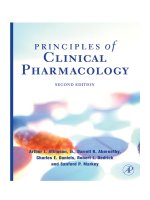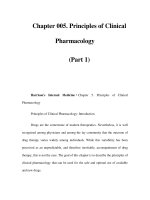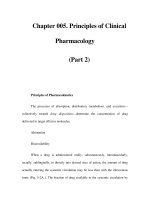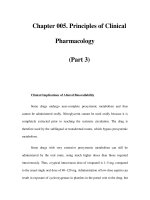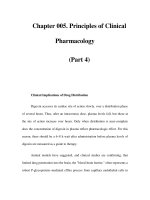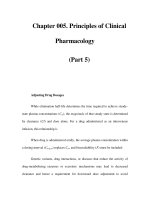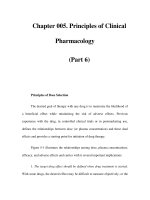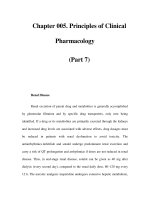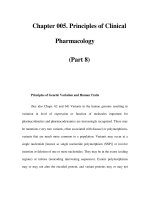Chapter 005. Principles of Clinical Pharmacology (Part 10) doc
Bạn đang xem bản rút gọn của tài liệu. Xem và tải ngay bản đầy đủ của tài liệu tại đây (21.64 KB, 8 trang )
Chapter 005. Principles of Clinical
Pharmacology
(Part 10)
Multiple Variants Modulating Drug Effects
As this discussion makes clear, for each drug with a defined mechanism of
action and disposition pathways, a set of "candidate genes," in which
polymorphisms may mediate variable clinical responses, can be identified. Indeed,
polymorphisms in multiple genes have been associated with variability in the
effect of a single drug. CYP2C9 loss-of-function variants are associated with a
requirement for lower maintenance doses of the vitamin K antagonist
anticoagulant warfarin. In rarer (<2%) individuals homozygous for these variant
alleles, maintenance warfarin dosages may be difficult to establish, and the risk of
bleeding complications appears increased. In addition to CYP2C9, variants in the
promoter region of VKORC1, encoding a vitamin K epoxide reductase, predict
warfarin dosages; these promoter variants are in tight linkage disequilibrium , i.e.
genotyping at one polymorphic site within this haplotype block provides reliable
information on the identity of genotypes at other linked sites (Chap. 62). Thus,
variability in response to warfarin can be linked to both coding region
polymorphisms in CYP2C9 and promoter haplotypes in the warfarin target
VKORC1.
As genotyping technologies improve and data sets of patients with well-
documented drug responses are accumulated, it is becoming possible to interrogate
hundreds of polymorphisms in dozens of candidate genes. This approach has been
applied to implicate linked noncoding polymorphisms in the HMG-CoA reductase
gene as predicting efficacy of HMG-CoA reductase inhibitors, and in variants in
the gene-encoding corticotrophin-releasing hormone receptor 1 as predicting
efficacy of inhaled steroids in asthma.
Technologies are now evolving to interrogate hundreds of thousands of
SNPs across the genome, or to rapidly resequence each patient's genome. These
approaches, which have been applied to identify new genes modulating disease
susceptibility (Chap. 62), may be applicable to the problem of identifying genomic
predictors of variable drug effects.
Prospects for Incorporating Genetic Information into Clinical Practice
The examples of associations between specific genotypes and drug
responses raise the tantalizing prospect that patients will undergo routine
genotyping for loci known to modulate drug levels or response prior to receiving a
prescription. Indeed, clinical tests for some of the polymorphisms described
above, including those in TPMT, UGT1A1, CYP2D6, and CYP2C19, have been
approved by the U.S. Food and Drug Administration (FDA). The twin goals are to
identify patients likely to exhibit adverse effects and those most likely to respond
well. Obstacles that must be overcome before this vision becomes a reality include
replication of even the most compelling associations, demonstrations of cost-
effectiveness, development of readily useable genotyping technologies, and ethical
issues involved in genotyping. While these barriers seem daunting, the field is
very young and evolving rapidly. Indeed, one major result of understanding of the
role of genetics in drug action has been improved screening of drugs during the
development process to reduce the likelihood of highly variable metabolism or
unanticipated toxicity (such as torsades des pointes).
Interactions between Drugs
Drug interactions can complicate therapy by increasing or decreasing the
action of a drug; interactions may be based on changes in drug disposition or in
drug response in the absence of changes in drug levels. Interactions must be
considered in the differential diagnosis of any unusual response occurring during
drug therapy. Prescribers should recognize that patients often come to them with a
legacy of drugs acquired during previous medical experiences, often with multiple
physicians who may not be aware of all the patient's medications. A meticulous
drug history should include examination of the patient's medications and, if
necessary, calls to the pharmacist to identify prescriptions. It should also address
the use of agents not often volunteered during questioning, such as over-the-
counter (OTC) drugs, health food supplements, and topical agents such as eye
drops. Lists of interactions are available from a number of electronic sources.
While it is unrealistic to expect the practicing physician to memorize these, certain
drugs consistently run the risk of generating interactions, often by inhibiting or
inducing specific drug elimination pathways. Examples are presented below and in
Table 5-2. Accordingly, when these drugs are started or stopped, prescribers must
be especially alert to the possibility of interactions.
Table 5-
2 Drugs with a High Risk of Generating Pharmacokinetic
Interactions
Drug Mechanism Examples
Antacids
Bile acid
Reduced
absorption
Antacids/tetracyclines
Cholestryamine/digoxin
sequestrants
Proton pump
inhibitors
H
2
-receptor
blockers
Altered gastric
pH
Ketoconazole absorption
decreased
Rifampin
Carbamazepine
Barbiturates
Phenytoin
St. John's wort
Glutethimide
Induction of
hepatic metabolism
Decreased concentration and
effects of
warfarin
quinidine
cyclosporine
losartan
oral contraceptives
methadone
Tricyclic
Inhibitors of
Increased -blockade
antidepressants
Fluoxetine
Quinidine
CYP2D6 Decreased codeine effect
Cimetidine In
hibitor of
multiple CYPs
Increased concentration and
effects of
warfarin
theophylline
phenytoin
Ketoconazole,
itraconazole
Erythromycin,
clarithromycin
Calcium channel
blockers
Ritonavir
Inhibitor of
CYP3A
Increased concentration and
toxicity of
some HMG-
CoA reductase
inhibitors
cyclosporine
cisapride, terfenadine (now
withdrawn)
Increased concentration and
effects of
indinavir (with ritonavir)
Decreased clearance and
dose requirement for cyclosporine
(with calcium channel blockers)
Allopurinol Xanthine
oxidase inhibitor
Azathioprine and 6-
mercaptopurine toxicity
Amiodarone
Inhibitor of
many CYPs and of P-
glycoprotein
Decreased clearance (risk of
toxicity) for
warfarin
digoxin
quinidine
Gemfibrazol
(and other fibrates)
CYP3A
inhibition
Rhabdomyolysis when co-
prescribed with some HMG-
CoA
reductase inhibitors
Quinidine
Amiodarone
Verapamil
Cyclosporine
Itraconazole
Erythromycin
P-
glycoprotein
inhibition
Risk of digoxin toxicity
Phenylbutazone
Probenecid
Salicylates
Inhibition of
renal tubu
lar
transport
Salicylates increased risk of
methotrexate toxicity
